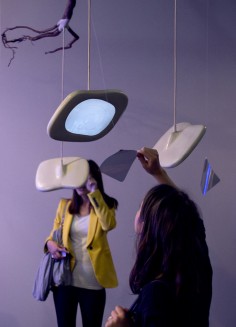Misha Margolis
La racine

source: artshebdomedias
Avec La racine, une installation multimédia interactive présentée ici pour la première fois, Misha Margolis, artiste Russe installé à Paris, poursuit la réflexion engagée sur l’histoire, le temps et la mémoire. Le public se retrouve au pied d’une énorme racine déterrée et suspendue au plafond. A travers des filtres spéciaux, il peut découvrir une série d’images animées faisant apparaître des personnes de différents âges (tous appartenant à une même famille), occupées à diverses activités. L’environnement circulaire fait référence au cycle de la vie humaine et, par conséquent, au cycle de vie de l’arbre même. Pour Misha Margolis, il était important d’établir une forme d’harmonie entre la forme organique des racines et les composants technologiques utilisés dans l’installation. Mû par un profond respect de la nature, il a tenu à déplacer lui-même la racine de son lieu d’origine. .
.
.
.
.
.
.
source: linkedin
A l’occasion de sa deuxième exposition personnelle à la Galerie Charlot, Misha Margolis a conçu et réalisé «La racine, The root», une installation multimédia qui sera montrée pour la première fois.
Misha Margolis prolonge la réflexion commencée avec sa première installation, «Mémo», sur l’histoire, le temps et la mémoire.
Comme un historien qui ouvre ses archives, à travers une technologie sophistiquée, Misha Margolis nous faisait plonger dans une histoire douloureuse de séparation entre enfants et parents déportés sur fond de Russie stalinienne.
Poursuivant la même démarche, « La racine » est une installation où l’on découvre la mémoire individuelle et collective des hommes et des femmes qui appartiennent à un temps indéfini, entre passé, présent et futur, souvenirs de famille.
Les racines végétales sont les cartes mémoire de l’histoire des hommes.
.
.
.
.
.
.
.
source: aqnb
To start the year the gallery invited the French painter Dominique Albertelli at street level, and the Russian artist Misha Margolis to occupy the basement space with his piece ‘La Racine’ (‘The Root’). This amazing installation work consists in an actual three-meter-long tree root fixed to the ceiling of the room. From it hang five white screens and five squares of polarizing films through which, individually held, the images on the screens magically appear.
On each screen a different animation is shown: they are simple and poetic, and depict an ideal of rural and family life. Two to three generations of persons from the same family are shown in repetitive everyday doings under a bright blue sky. Altogether the room is quite dark and the atmosphere is eerie for you can hear the mixed sounds of the looping animations like a melody of birds singing and doors creaking.
It is interesting to see how the audience acts with this multimedia installation: for in a group of persons, each individually stares through the polarizing film, everyone bearing the same attitude while actually reflecting on how the images they see relate to themselves, their family history or their values. The film is like our personal handheld lens, and the five apparatus create five individual theaters.
As for the aspect of the sculpture in itself, even if an equality of treatment was given to the technologic parts and the natural parts, gravity still differentiates the two. The roots are very light and seem to crawl in the air a few inches under the ceiling, while the screens are heavy and hanging from very straight vertical cords. This ironic contrast is even more striking when you realize you are watching beautiful landscapes fixed on a tree-root, in a small Parisian basement. Overall the aspect of the sculpture is still spectacular and the lack of finishing touches only appear as an extension of the artist’s desire for spontaneity.
On the ground floor, colourful paintings and drawings from Dominique Albertelli are on display. Two series of small square drawings, ‘Femmes d’ici ! (et d’ailleurs)’, (‘Women from here! (and elsewhere)’) are presented in a narrowed fashion, and three larger paintings on canvas are hanging on the opposite wall. The two series are portraits of imaginary women, often in close-up, wearing colourful and boldly patterned clothes. In some drawings some elements from the sea – fish, shells, or algae-looking hair – are to be seen, but mainly the only decor for those women is their own aura represented by coloured floating dots.
Among other techniques the artist uses charcoal and watercolour, which gives the smaller drawings an appreciated sketchy aspect. A documentary video shows her in the midst of creation, and her speed drawing movements are hypnotizing. Her larger paintings are also portraits, but this time full-length and situated in a more elaborate background. The artist says that she usually uses even bigger canvases and paints mainly with the colour red, and that the grey, orange and light pink pieces presented there are an exception in her work. One painting stands out: ‘Au-delà des mots’ (‘Beyond words’) has more ink-like drippings and a more sophisticated composition than the other two. The depicted characters are very resembling to those in the other paintings, but the watery texture and the absence of horizon really gets our attention.
.
.
.
.
.
.
.
source: galeriecharlot
Mikhail Margolis est né et a grandi à Moscou, en Russie. En 2000, il arrive à Paris, où il vit et travaille depuis 15 ans et poursuit son travail artistique créant des oeuvres associant l’art, la technologie et l’histoire.

